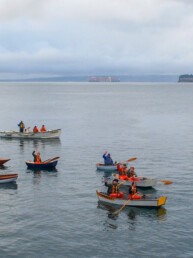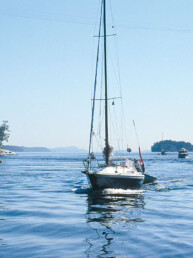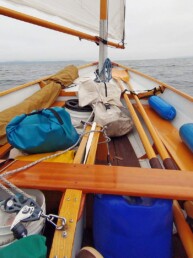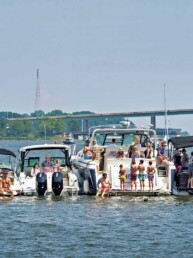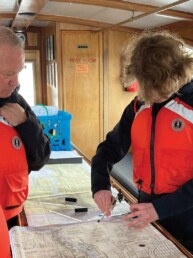
Who are the experts on the experience of overboard recovery? It’s the people who’ve had it happen to them in real life, not in a practice drill. This article is a window into the experience of those experts—local boaters who have been overboard and are willing to share what they learned from their experiences. Some stories may be familiar, others may not.
Before we get into it, you’ll see that all of the survivors featured here are women. This is purely coincidental. I have no data that suggests that women go overboard disproportionately often. This is just a result of the fact that I have a lot of connections with the local women’s boating community, and that’s who happened to respond to my inquiries for this story.
1. An overboard situation can happen to anyone.
Most boaters think it won’t happen to them, yet two survivors interviewed for this article are professional captains and instructors and several others also have a lifetime of experience. Whether novice or savvy salt, cruising or racing, aboard large boats or small, sail or power, no one is immune to the risks of going overboard.
2. Life jackets — just wear them.
You’ll meet lots of sailors who don’t wear life jackets. But I have yet to meet an expert on the overboard experience—a survivor—who doesn’t ALWAYS wear their PFD.
Put life jackets on before you leave the dock. Don’t assume you’ll put it on before the conditions pick up, or before you must go out of the cockpit, or when an emergency happens.
Consider the experience of Judy Rae Carlson from Port Orchard. She was the mainsail trimmer in a race that was predicted to be a light-wind drifter. When the winds slowly built to the point that she wanted her life jacket on, a crewmate retrieved it from the cabin for her. She had it in her lap so she could put it on… but before she did, a broach threw her head-first over the lifelines.
3. If not already integral, add crotch straps to your life jacket.
Fitting your inflatable life jacket with crotch straps should, and in many cases does, hold you higher in the water. It also prevents the inflated bladder from squeezing your neck, head, and ears, which can cause you to panic. This is common wisdom and is reflected in offshore racing requirements, but it strikes a more relevant chord from a person who saw the benefit firsthand.

Christina Carter of Seattle was sailing on the J/105, Last Tango, during a spring regatta in 2013. She had two years of sailing experience with a local sailing club, and had been crewing on this boat for a few races prior. She was on the foredeck, and the boat was doing its final tacks prior to a specific type of spinnaker set involving procedures she was less familiar with. Instead of crossing the foredeck during the tack (her typical route), she decided to go across under the boom so she didn’t trip on or foul the pre-set spinnaker gear. She skidded over the wet deck, where she expected to find a toe rail to stop her as there is on the foredeck, but there wasn’t one. She went off the boat underneath the life lines and was in the water for about ten minutes before being rescued by the same boat from which she’d fallen.
After the experience, Carter said, “I had learned about crotch straps at the Offshore Safety at Sea class. I was so glad I put them on my inflatable life jacket when I went overboard. I tightened them down when I was in the water, which made me much more comfortable.”
4. Overboard events often happen quickly.
Crewmates may not even realize it’s happened, which makes a whistle and light on your life jacket particularly important. Sometimes more than one person goes overboard.
Aubre Lawless Nelson of Seattle says, “My advice is, make sure to yell! I slipped overboard on the leeward side under the sail, and they didn’t even realize I was gone.” That’s a scary thought, but it’s one to keep in mind when considering your preparation and readiness in the event that you wind up in the water. It also reinforces the need for equipment that can make you easier to find.

Tacoma sailor Elaine Cashar gives us another perspective on how fast a person can go overboard. “I was racing on a Soverel 33 sailing under spinnaker. The pole dipped into the water, spun around, and broke the mast. I was on the coachroof as a human preventer for the boom. Suddenly, I was in the water. I don’t even remember how it happened. This was not what I expected. I thought I would have been more aware as the ‘accident’ was happening.”
Cashar’s memory of the aftermath is clearer. She says, “I remember that the water was strangely warm. The crew grabbed my foot to pull me in, which was possible because the boat was not moving at the time. I was a bit dazed. When I was pulled back on board, I was not sure what to do next and had to be told to go down below and get out of my wet clothes. Was this shock? Probably.”
5. Have a Lifesling, and make sure everyone on board knows how to use it as both rescuer and the person in the water.
Dolly Lieber of Seattle was 67 years young when she was the crew overboard for the first time after a lifetime of boating experience. She was sailing on the J/35 Intrepid and the team was preparing for a casual buoy race on a blustery Saturday morning in January 2019. They had a crew of two men and five women of varying experience levels when they sailed out of Dumas Bay north of Tacoma. The water temperature was 51°F.

This is how Lieber described her situation: “I was working foredeck with a highly experienced male crewmember and we were waiting for a totally inexperienced female to release the back-winded jib sheet. She had no idea what she was doing, didn’t even know the basic boat terminology. I was standing at the mast to help the jib around the shroud when she threw her line off the winch and both of the jib sheets and clew came flying at me. I stepped back to avoid being pummeled, and the new working jib sheet flew beneath me. When the trimmer tightened the sheet as quickly as she could, it picked me up and flung me over the lifelines. I clipped the shrouds and plunged into Puget Sound.”
Lieber continues, “Intrepid skipper, Patrick Robinson, teaches man overboard classes, so I was very blessed to have such a skilled and experienced person in charge of my rescue. He was textbook perfect, deploying the MOB flag and life ring, dropping the jib, and freeing the halyard to pull me out of the water. They deployed the Lifesling and circled me, grabbing me on their first pass.”
Noting her inexperience with the Lifesling, Lieber says, “I didn’t know how to put the Lifesling around me, so I held onto the tow rope for dear life” while her foredeck compatriot pulled her in. She was wearing an auto-inflate life jacket with crotch straps and spray hood, which she says kept her from drowning while being pulled backwards.
Getting Lieber back on board was its own challenge. She says the two men on the crew were strong and knew exactly what to do, but the women were not as strong, experienced, or knowledgeable. They had an overwrap issue when using the halyard to try to hoist her aboard, resulting in Lieber being dropped back into the water. She says, “I was having a really hard time breathing because the water was so cold, so that wasn’t much fun.” Eventually they got her back aboard. Lieber thinks that the wide range of crew experience made the process more difficult, but having a core crew who knew what to do and how to use the key equipment was essential.
6. Even if you’re a great swimmer, you’re in danger if you fall overboard into cold water.
There are three principal elements that make it inadvisable to rely upon swimming skills if you go overboard in cold water: the Cold Shock response, cold incapacitation, and movement restrictions in your gear.
The Cold Shock response happens when sudden immersion in cold water triggers an immediate, involuntary deep gasp reflex. You can’t help it. This gasp is followed by hyperventilation up to ten times faster than normal breathing. If your nose and mouth are underwater when these involuntary responses occur, there’s a risk of drowning.
Linda Lewis is a USCG 100-ton captain and private boating instructor with decades of experience. She went into the water during a seemingly mundane maneuver, turning a 21-foot boat end-for-end at the launch ramp in Everett. She was leaning over the water too far when a boat hook failed. “That inhale reflex when you hit the water is real,” Lewis said. “I was amazed to see how much water was in my mouth. I had to spit out water twice to be able to speak.” Was she wearing a life jacket? “YOU BET I WAS. It inflated immediately.”
Even if you get past the immediate risks of Cold Shock response, the process of cold incapacitation begins nearly immediately. As cold water lowers body temperature, chilled muscles in your hands, arms, and legs become ineffective. If you can’t control your muscles, you can’t swim, or grab a line thrown to you. Likewise, people in cold water often lose the ability to think clearly. This is related to hypothermia, but it is not the same thing and is a more immediate danger. According to Dr. Gordon Giesbrecht, a Canadian physiologist who studies the effect of extreme environments on the human body, it might be an hour before a person in cold water succumbs to hypothermia. Typically, a person not wearing a life jacket will drown from cold incapacitation before this time.
Suddenly, I was in the water. I don’t even remember how it happened. This was not what I expected. I thought I would have been more aware as the ‘accident’ was happening.
Elaine Cashar
Good foulies are essential in the Pacific Northwest. And if you’ve read this far, you know how important it is to wear a life jacket. But for all the good this gear does for sailors, in the water your foulies can be a literal drag, and you shouldn’t expect to swim any distance with an inflated PFD. The swimming difficulty further reinforces the need for on-board safety equipment like a Lifesling, which can help you get back to the boat without having to swim. When Dolly Lieber was in the water with her life jacket, she realized, “I couldn’t swim forward to the MOB flag with the chest inflation. I just flailed.”
7. Excellent procedures and fast response from the crew still on the boat does not necessarily mean a quick recovery, especially if there are multiple people in the water.
When Judy Rae Carlson went overboard, it was during an 81-mile coastal race. She was part of an all-woman crew of four very experienced offshore racers. Between them, they had raced eight Transpacs and about 50 Newport-to-Ensenada races. A knockdown slammed the boat on its side, and both Carlson (the mainsail trimmer) and Sue Senescu (the driver) were flipped off the boat. The crew was left at half-strength with the boat pinned on its side by the spinnaker.

Senescu was able to hang onto the stern pulpit. A quick-thinking crewmate, Betsy Crowfoot, grabbed the long bitter end of the tightened-down backstay and tied a quick bowline around Senescu to keep her attached to the boat before steep waves washed her away. (How quickly can you tie a bowline?)
Meanwhile, Carlson was not quite so lucky. Freeing herself from a tangle of lines, she didn’t see the horseshoe life-ring that another crewmember had thrown to her. It quickly blew out of reach. On the boat, Crowfoot had pulled the pin at the bottom of an inflatable man-overboard module (MOM), which is designed to drop into the water, inflate, and provide flotation and visibility for the victim. But since the boat was pinned on its side, it didn’t fall out, and stayed uselessly in its case.
With Senescu back on board, the women set about taking the spinnaker down, but not before the boat had drifted quite a distance from Carlson.
8. The COB might not have fallen off your boat.
Keep your eyes open, especially when racing. With Carlson still in the water now a significant distance from the boat, Crowfoot got on the VHF and issued a Mayday call, detailing the situation and their precise coordinates.
Other boats raced by Carlson so closely that she couldn’t believe they didn’t see her. She was ultimately rescued by skipper Bill Webster who happened to turn on his VHF radio in the middle of Crowfoot’s Mayday. He missed the “Mayday!” part of the hail, but heard an urgent voice stating a latitude and longitude. He wrote them down, even before he knew what the VHF transmission was regarding, then compared them to his GPS. Recognizing he was near the location, he alerted his crew to a possible COB nearby. They quickly spotted Carlson and rescued her using a Lifesling. At that point, she’d been in the water for about 45 minutes. Reflecting on the experience, Carlson said, “Sailing with my friends is an absolute thrill. Treading water alone in the ocean without safety gear is not.”

If you see something strange on the water, that might even possibly be a human, go investigate. Lindsey Lind of Bainbridge Island went overboard during a broach on a Flying Tiger 10 Meter while sailing in this year’s CYC Blakely Rock Race. Her story was featured in the April 2019 issue of 48° North. In that situation, there was some confusion in VHF radio transmissions. USCG monitors channel 16; but, racers monitoring VHF are often tuned to whatever channel the race committee has set.
Vessels in distress, such as a race boat broaching with a spinnaker, may need your help or may have lost a crew overboard during the wipeout. When describing being in the water and seeing the boat from which she fell continue to broach, Lind realized it would likely be some time before they could come back to rescue her.
Instead, she looked to the boats racing up from behind, but was dismayed to see some race by her quite closely without noticing she was there. Her rescue was facilitated by the TP52 Sonic, who saw her in the water and deployed an inflatable MOM device near her. This inflated a tall pylon near her that she was able to grab onto, not only giving her extra flotation, but also attracting the attention of the Thunderbird Selchie, the boat that rescued her from the water.
If you’re in the water at a place where boats will converge, such as a race mark, there are positives and negatives. If the other boats see you, they can avoid hitting you as well as potentially offering assistance. Unfortunately, there will be more traffic and sailors may be distracted by the racing processes on their respective boats. Christine Carter recalls, “I fell off right near the windward mark. The guys on my boat were afraid that I might not be seen by boats approaching the mark as they focused on preparing to set their spinnakers. Fortunately, two other boats saw and avoided me. In hindsight, I wish I’d waved at them to be sure. If you’re the person in the water, do all you can to attract the attention of the boats approaching you.”
I’d like to think that no racer, given the time to think clearly about it, would put winning a race over the safety of other human beings. But in the heat of the moment, skippers have been known to say that they “couldn’t” stop to potentially render assistance to a boat or person in distress because they were racing. Race crew have been known to say, “I wanted to stop and offer help, but didn’t want to go against my skipper.” Keep in mind that the Racing Rules of Sailing dictate: “Fundamental rule 1.1 Helping Those in Danger: A boat or competitor shall give all possible help to any person or vessel in danger.”
9. After a rescue, survivors and sometimes skippers have been through a traumatic experience and should be cared for and monitored both physically and emotionally.
Lindsey Lind describes telling her rescuers she was “fine” when she got back to the dock. Then when they left her, she became disoriented and confused in the parking lot.

The skippers of boats that have had crew go overboard are often very traumatized themselves, and have difficulty shaking a feeling of guilt, even if the crew who went overboard are recovered safely. Take care of each other, even after the immediate danger has passed.
Thank you to all the survivors who contributed their stories and lessons learned, and to others who shared their stories but were not featured in this article. Keep in mind that people don’t just go overboard when sailing, there are many other stories about going overboard during docking maneuvers, and these can be every bit as serious as overboard situations on open water. Stay safe out there!
This article was published in the November 2019 issue of 48° North
Margaret Pommert
A champion of safe sailing, Margaret Pommert is on the Board of Directors of The Sailing Foundation, organizes the US Sailing Offshore Safety-at-Sea seminar in our region, and serves on the US Sailing Safety-at-Sea’s Rescue Medal selection committee.

